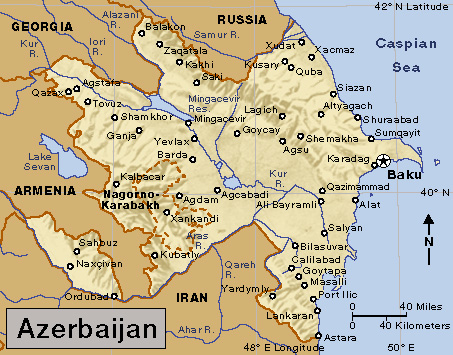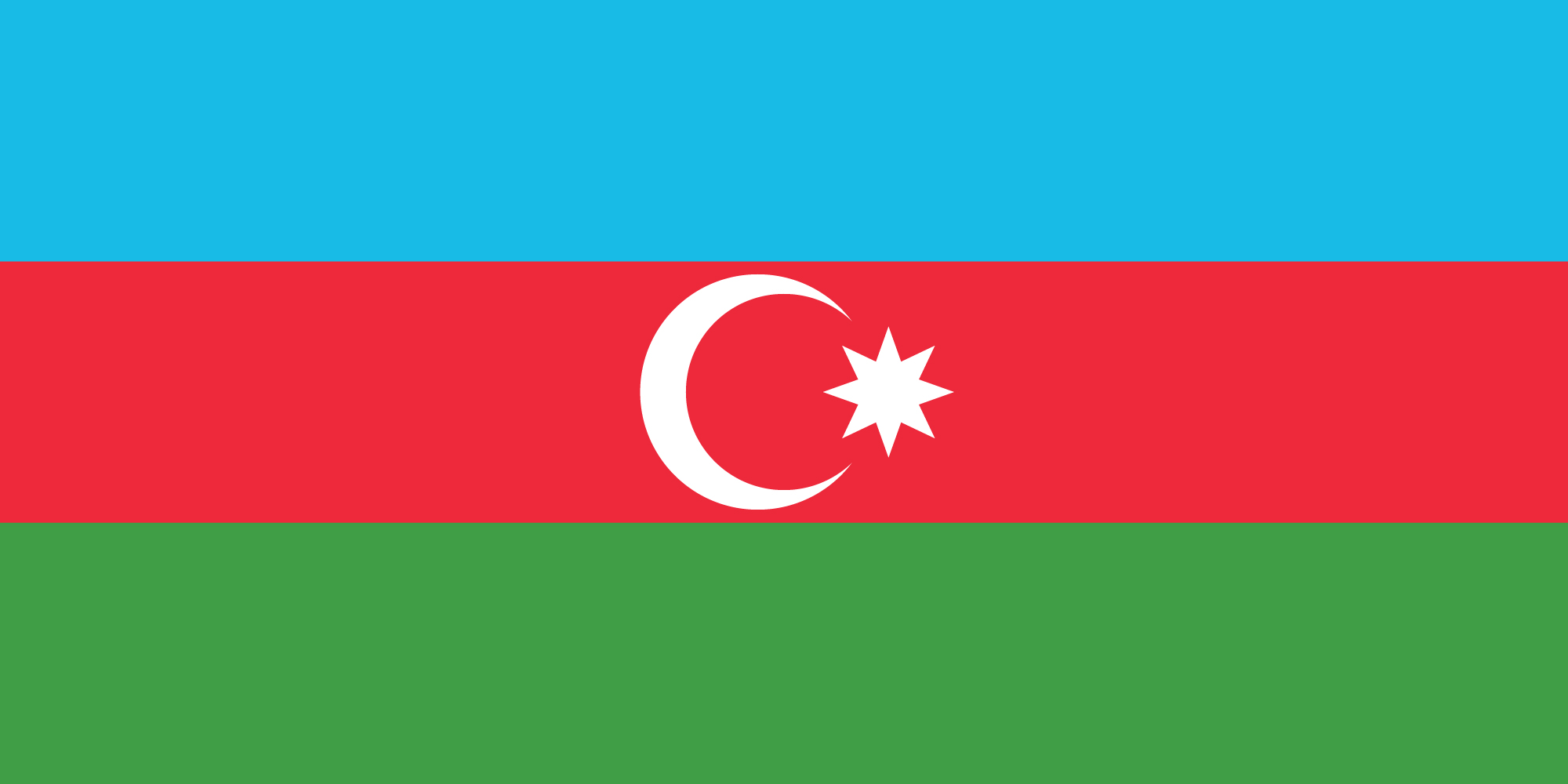Azerbaijan << AH zuhr by JAHN >> is a country in the Caucasus Mountain region on the western shore of the Caspian Sea. It is located mostly in southwestern Asia, but part of northern Azerbaijan is located in Europe. An area of Azerbaijan called the Naxçivan Autonomous Republic lies west of the rest of the country, separated from it by Armenian territory.

The country’s full name in Azerbaijani, the official language, is Azərbaycan Respublikasi (Republic of Azerbaijan). Baku is its capital and largest city. Azerbaijan became independent in 1991, after nearly 70 years as a part of the Soviet Union.
Government.
Under Azerbaijan’s Constitution, which became effective in 1995, the president is the country’s most powerful government official. The people elect the president to a seven-year term. A Cabinet of Ministers, headed by a prime minister, helps carry out the operations of government. The president appoints the Cabinet members. A 125-member parliament called the Milli Mejlis (National Assembly) makes the country’s laws. Voters elect the assembly members to five-year terms.

The main units of local government include the Naxçivan Autonomous Republic and districts, cities, and villages. Each unit elects a governing council to manage local affairs. All citizens 18 years old or older may vote.
Azerbaijan’s highest court is the Supreme Court. There are also regional courts.
Azerbaijan’s armed forces include a land force, an air force, and a navy. Men are required to serve in the armed forces.
People.
Most of Azerbaijan’s people are ethnic Azerbaijanis. Lezgins and Russians make up the largest minority groups.
In Azerbaijan’s cities, most people live in multistory apartment buildings. In rural areas, most of the people live in one- or two-story houses.
Most Azerbaijanis are Shī`ite Muslims. Many Russians are Russian Orthodox Christians.
Most people in Azerbaijan wear clothing similar to that worn by North Americans and Europeans. On holidays, some men wear a traditional costume consisting of pants, a long shirt, boots, and a long jacket. Some rural women wear wide skirts and blouses with long, wide sleeves. Muslim women in rural areas often wear a black shawl that covers the head and shoulders and may be drawn over the face. The wearing of the shawl is based on a Muslim custom.
The Azerbaijani language developed from the languages of Persians and Turkic people who once inhabited the region. Today, Azerbaijani closely resembles the modern Turkish language.
Azerbaijanis enjoy pilaf (a rice dish) and a variety of grilled and boiled meats, including beef, goat, and lamb. Traditional dishes include bozartma (mutton stew) and dovga (soup made of yogurt, meat, and herbs). Tea and wine are popular drinks.
Soccer is a popular sport in Azerbaijan. Many people walk or swim for recreation. Men spend much of their leisure time talking with one another in teahouses.
Azerbaijanis are known for their handwoven rugs. Also, their brightly patterned shawls are highly admired.
Nearly all adults in Azerbaijan can read and write. The government requires children to attend school from the ages of 6 to 15. The country has several universities.
Land and climate.
The Caucasus Mountains rise in northern Azerbaijan, and the Little Caucasus Mountains stretch across the western part of the country. The area north of the Caucasus Mountains is considered part of Europe. The area south of the range is considered part of Asia. Azerbaijan’s highest mountain, Bazardyuzyu, rises 14,652 feet (4,466 meters) above sea level in the Caucasus Mountains.
The rugged Armenian Plateau, a land broken by deep gorges, covers part of southwestern Azerbaijan. The Kur, the country’s main river, flows through the central valley between the mountain ranges and across a broad, dry plain called the Kur-Aras Lowland. From the lowland, the Kur drains into the salty Caspian Sea. The Kur’s main tributary, the Aras, flows along part of Azerbaijan’s southern border. Other important rivers in Azerbaijan include the Terter and the Akera. The rivers serve as a source of irrigation water and energy. The Mingacevir dam on the Kur River provides hydroelectric power for Baku and the Ganja industrial region.
Summers in the lowlands are long and hot. Winters are cool. The lowlands have an average temperature of 79 °F (26 °C) in August and 39 °F (4 °C) in January. Parts of the Caucasus Mountains have average temperatures of 56 °F (13 °C) in August and 21 °F (6 °C) in January. Annual precipitation ranges from about 5 to 15 inches (13 to 38 centimeters) in most of the country’s lowland areas. The highlands and a region in southeastern Azerbaijan on the Caspian Sea receive about 40 to 55 inches (100 to 140 centimeters) of precipitation every year.
Economy.
Industry accounts for about half of the value of Azerbaijan’s economic production. The country’s industrial activities include building oil field equipment, mining, processing chemicals, producing steel, and refining petroleum. The chief industrial cities are Baku, Ganja, and Sumqayit.
Petroleum ranks as the country’s most important mined product by far. The largest producing oil fields lie in the Baku region, in the Caspian Sea, and on the sea’s western shore. Oil pipelines link Baku with ports on the Mediterranean Sea and Black Sea. Azerbaijan’s other mined products include aluminum, copper, gold, natural gas, salt, and silver.
Agriculture employs many Azerbaijani workers. Farmers in the lowlands grow such crops as apples, barley, cotton, grapes, potatoes, tomatoes, and wheat. Some farmers raise silkworms for the raw silk industry. Herders raise cattle, goats, and sheep on mountain slopes. The Caspian Sea is a source of fish.
Azerbaijan’s main export is crude petroleum. It also exports cotton and food. The country imports food, machinery, metals, and vehicles. Azerbaijan’s trading partners include Indonesia, Italy, Russia, Turkey, and the United Kingdom.
Internet and cell phone usage has increased rapidly since the early 2000’s. A port at Baku handles most of the country’s trade on the Caspian Sea. The main international airport is at Baku.
History.
People have lived in the region that is now Azerbaijan since prehistoric times. Medes invaded the region in the 700’s B.C. Later invaders were Persians of the Achaemenid Empire in the 500’s B.C. and Alexander the Great in the 300’s B.C. Persians of the Sasanian dynasty controlled much of the region from the A.D. 200’s until the 600’s, when the Arabs conquered the area. The Arabs introduced Islam, the Muslim religion.
From the 1000’s to the 1200’s, Turkic tribes migrated into the region in large numbers and mixed with the Persians who lived there. These people became the ancestors of the Azerbaijanis. In the early 1500’s, Azerbaijan fell to the Safavid Empire, which ruled Iran (see Safavid dynasty). The Ottoman Empire took control of Azerbaijan from the Safavids in the late 1500’s but lost it to them again in the early 1600’s.
In the early 1800’s, Russia gained control of what is now Azerbaijan. Under Russia, industry, especially petroleum production, developed in Azerbaijan. By the late 1800’s, Baku had become the world’s leading producer of refined petroleum.
In 1917, revolutionaries known as Bolsheviks (later called Communists) seized control of the Russian government. In 1918, Azerbaijani nationalists set up an independent state in western Azerbaijan. But the Russians regained the area in 1920.
Soviet rule.
In early 1922, Azerbaijan, Georgia, and Armenia combined to form the Transcaucasian Republic under Russia’s leadership. Later that year, the Transcaucasian Republic joined Byelorussia (now Belarus), Russia, and Ukraine to form the Soviet Union. In 1936, the three parts of the Transcaucasian Republic became separate republics of the Soviet Union. Azerbaijan was called the Azerbaijan Soviet Socialist Republic.
The Soviet Union established a powerful central government and took control of Azerbaijan’s industry and land. The Soviet Union collectivized agriculture in Azerbaijan—that is, it severely restricted private farming and transferred control of farms to the government. The Soviet rulers destroyed many Azerbaijani traditions, and they tried to reduce the influence of Islam. They closed down almost all mosques and religious schools in Azerbaijan. But the Soviets also built roads, schools, modern housing, hospitals, and communication systems.
Independence.
The Soviet government maintained strict control until the late 1980’s. In 1989, Azerbaijan declared that its own laws overruled the laws of the Soviet Union. In August 1991, conservative Communist officials failed in an attempt to overthrow the president of the Soviet Union, Mikhail S. Gorbachev. During the upheaval that followed, Azerbaijan and several other republics of the Soviet Union declared their independence. In December, Azerbaijan joined other republics in a loose association called the Commonwealth of Independent States. The Soviet Union was formally dissolved on December 25.
In 1992, the Azerbaijani government slowly began to pass laws that encouraged a free-enterprise economy. But most of the economy continued under government control. Most of the country’s people remained very poor. Many homes did not have such features as electric power.
In 1992, Abulfaz Elchibey was elected president of Azerbaijan. In June 1993, a rebel uprising forced Elchibey to flee the capital, Baku. Heydar Aliyev was appointed acting president. In October 1993, Aliyev was elected president. He was reelected in 1998.
Dispute over Nagorno-Karabakh.
An area known as Nagorno-Karabakh in southern Azerbaijan has been a source of dispute between Azerbaijan and neighboring Armenia. Until 2023, most of Nagorno-Karabakh’s people were Armenians, and Armenia claimed the area. In early 1988, Nagorno-Karabakh petitioned to become part of Armenia. This action triggered fighting between Azerbaijanis and Armenians over the issue of control of Nagorno-Karabakh. After the violence began, about 200,000 Azerbaijanis—almost all those who lived in Armenia—fled to Azerbaijan. About 250,000 Armenians fled Azerbaijan for Armenia. In 1994, the two countries declared a cease-fire. Ethnic Armenian forces controlled Nagorno-Karabakh and some surrounding Azerbaijani territory, and Nagorno-Karabakh established its own elected government. However, fighting continued from time to time, and the conflict over the territory remained unresolved.
Recent developments.
In the middle and late 1990’s, Azerbaijan made progress in selling government-owned farmland and businesses to private owners. It signed agreements with foreign oil companies for supplies of oil from the Caspian Sea. The agreements proved profitable for Azerbaijan.
In 2003, Heydar Aliyev did not run for reelection as president of Azerbaijan because of poor health. Voters elected his son Ilham to succeed him as president. Heydar Aliyev died later that year. Ilham Aliyev was reelected in 2008. In 2009, voters approved amending the Constitution to allow the president to run for an unlimited number of terms in office. Ilham Aliyev was reelected in 2013 and 2018.
In 2020, serious fighting flared between Azerbaijan and Armenia. Azerbaijan regained some lands in and near Nagorno-Karabakh. A truce arranged by Russia allowed Azerbaijan to keep these lands and some other nearby areas. Some Russian peacekeeping forces remained in the region to monitor and enforce the truce.
In September 2023, Azerbaijan launched a new military operation in Nagorno-Karabakh. The rebel forces in the region collapsed quickly, and both sides agreed to a cease-fire a day later. The government of Nagorno-Karabakh declared that it would cease to exist on Jan. 1, 2024, giving Azerbaijan full control of the region. Azerbaijan pledged to respect the rights of Nagorno-Karabakh’s Armenian population. But almost all of Nagorno-Karabakh’s Armenians quickly fled to Armenia, leaving the region almost unpopulated.
